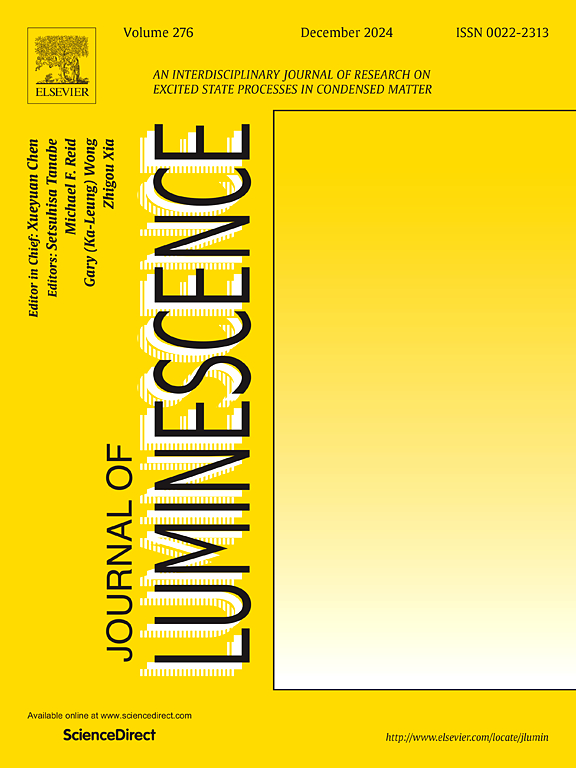Synthesis and properties of organic fluorescent molecules for blue to red conversion for LED systems using energy transfer
IF 3.3
3区 物理与天体物理
Q2 OPTICS
引用次数: 0
Abstract
The efficiency of color conversion in remote phosphor light emitting diode (LED) applications can be improved by direct blue to red conversion instead of blue to yellow to red conversion. In this publication, two molecules that have chemically linked blue light absorbing donor and red emitting acceptor moieties were synthesized in which the blue to red conversion takes place via Förster resonance energy transfer (FRET). The properties of these so called “FRET molecules” were studied in poly(methyl methacrylate) (PMMA) films and compared with those of the parent yellow and red fluorescent molecules. The quantum efficiency (QE) of these films depends strongly on the chemical structure of the blue light absorbing moiety. The molecule with high QE showed an increased photochemical stability of the blue light absorbing moiety compared to that of the parent yellow fluorescent molecule and a decreased photochemical stability of the red emitting moiety compared to that of the parent red fluorescent molecule.
利用能量转移的LED系统中用于蓝红转换的有机荧光分子的合成和性质
远程荧光粉发光二极管(LED)应用中的颜色转换效率可以通过直接蓝到红转换而不是蓝到黄到红转换来提高。在这篇文章中,合成了两个具有化学连接的蓝光吸收供体和红色发射受体的分子,其中蓝色到红色的转换通过Förster共振能量转移(FRET)发生。在聚甲基丙烯酸甲酯(PMMA)薄膜中研究了这些所谓的“FRET分子”的性质,并与母体黄色和红色荧光分子的性质进行了比较。这些薄膜的量子效率(QE)很大程度上取决于蓝光吸收部分的化学结构。具有高QE的分子,其蓝光吸收部分的光化学稳定性比母体黄色荧光分子高,而其红色发光部分的光化学稳定性比母体红色荧光分子低。
本文章由计算机程序翻译,如有差异,请以英文原文为准。
求助全文
约1分钟内获得全文
求助全文
来源期刊

Journal of Luminescence
物理-光学
CiteScore
6.70
自引率
13.90%
发文量
850
审稿时长
3.8 months
期刊介绍:
The purpose of the Journal of Luminescence is to provide a means of communication between scientists in different disciplines who share a common interest in the electronic excited states of molecular, ionic and covalent systems, whether crystalline, amorphous, or liquid.
We invite original papers and reviews on such subjects as: exciton and polariton dynamics, dynamics of localized excited states, energy and charge transport in ordered and disordered systems, radiative and non-radiative recombination, relaxation processes, vibronic interactions in electronic excited states, photochemistry in condensed systems, excited state resonance, double resonance, spin dynamics, selective excitation spectroscopy, hole burning, coherent processes in excited states, (e.g. coherent optical transients, photon echoes, transient gratings), multiphoton processes, optical bistability, photochromism, and new techniques for the study of excited states. This list is not intended to be exhaustive. Papers in the traditional areas of optical spectroscopy (absorption, MCD, luminescence, Raman scattering) are welcome. Papers on applications (phosphors, scintillators, electro- and cathodo-luminescence, radiography, bioimaging, solar energy, energy conversion, etc.) are also welcome if they present results of scientific, rather than only technological interest. However, papers containing purely theoretical results, not related to phenomena in the excited states, as well as papers using luminescence spectroscopy to perform routine analytical chemistry or biochemistry procedures, are outside the scope of the journal. Some exceptions will be possible at the discretion of the editors.
 求助内容:
求助内容: 应助结果提醒方式:
应助结果提醒方式:


